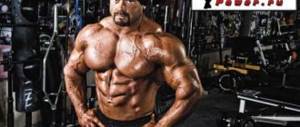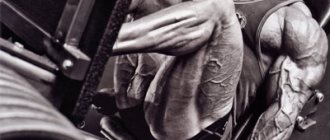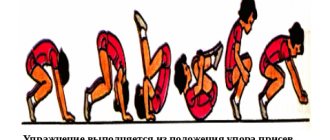Split training (English split - to split, split) is a method of constructing sports activities, which involves dividing the training program into parts and performing them on different days. This principle is used in bodybuilding and helps the athlete to load the necessary muscles well in a short period of time.
Advantages of the technique:
- Accented elaboration . Each lesson is aimed at developing a selected muscle group, which allows you to gradually increase weight loads.
- Optimal rest . Thanks to the separate principle, the risk of overtraining is reduced, and the muscles have enough time to recover.
- Increasing the intensity of classes . Using the split method, the athlete gets the opportunity to conduct short but effective workouts.
The use of split programs contributes to the development of strength characteristics and stimulates hypertrophy of muscle fibers.
Split by body part
This is the most common option in bodybuilding - frequent training (up to 5-6 times a week), each of which works specific muscles.
Pros: You load a muscle group rarely, but with concentration and intensity, performing more different exercises. This “shock” causes the muscles to grow, especially if you have previously trained in a full-body program. This is the best way to gain mass, but due to the increased volume and metabolic stress, it is suitable for experienced bodybuilders who are prepared for heavy loads.
Cons: You have to give up multi-joint exercises, since some muscles work in different movements and do not have time to rest between workouts.
You need to carefully monitor your diet and daily (sleep) routine in order to fully recover and tolerate training loads.
Split by body part takes a lot of time and is not suitable for people with a flexible work schedule - each workout loads its muscles, you cannot skip it. The goal of such a program is hypertrophy, it does not improve the performance of athletes and is not suitable for beginners.
Split example
Monday: Chest Tuesday: Back Wednesday: Shoulders Thursday: Legs Friday: Arms and Abs Saturday and Sunday: Rest
Recommendations for beginners
These tips will help inexperienced athletes get the maximum benefit from their training:
- Don't start bodybuilding straight away with splits. Prepare your muscles and ligaments with circuit training.
- Do not copy the programs of famous athletes. Choose your plan based on your physical fitness and body type.
- Don't overdo isolation exercises. Additional elements do not replace the basic ones.
- Keep an eye on your technique. It is not always possible to increase the load with each workout. It is better to perform the approach with the weight of the previous lesson, but technically correct.
- In the first months of training, do not push your muscles to the limit. Complete the approach before failure occurs.
- Do not delay the duration of the lesson. 50–60 minutes is enough to effectively load the target muscles.
While in the gym, monitor how you feel. If you feel a strong stretch or even more acute pain in the joint, discard the element and replace it with a safe analogue.
Top-bottom split
This scheme is a step from full body training to sectional splits. You increase the volume of exercise for the upper and lower half, but at the same time recover better. Over the course of one week, you can do 4 alternating workouts.
Pros: Top-bottom splits help you progress when full-body workouts have run their course. You continue to develop strength and gain mass. You can train more often, but use decent weights.
Cons: Many people get too carried away with their top workouts and become complacent with their bottom workouts. Since the same groups are worked more often, muscle recovery is worse than in a body part split. Heavy leg training twice a week can be taxing on the body and isn't for everyone.
Split example
Monday: Top (pressing exercises) Tuesday: Bottom (squats and variations) Wednesday: Complete rest or active recovery Thursday: Top (pulling exercises) Friday: Bottoms (deadlifts and variations) Saturday and Sunday: Rest
Creating a three-day split[edit | edit code]
You can divide the muscles of the body into three separately worked groups in various ways. For example,
- Back-biceps
- Legs-shoulders
- Chest-triceps
or
- Back-chest
- Biceps-triceps
- Legs-shoulders
or
- Chest-shoulders
- Back-triceps
- Legs-biceps
or some other way. There are many options and most of them have a right to exist. Each of them has some advantages over others. Let's look at the most popular three-day split options for beginner athletes below:
Full body workout
To be fair, “full body training” is not exactly a “split”, but for the harsh and brutal T-Nation authors, it seems that full body training is just one of the varieties of split - approx. Zozhnik.
Working out the whole body in each workout is more effective if you have little time, and also healthier, because our body is still one whole, and not a collection of parts.
Pros: High-frequency full-body workouts help you lose weight and build strength by increasing the muscle size that grows with frequent stimulation.
This program is better for athletes who have other training besides iron. It teaches the body to optimally perform a small set of movements, rather than wasting effort on a dozen variations of movements.
Beginners should start with these workouts; they burn a lot of calories, lay a strength foundation, and improve health.
Cons: According to the authors of the text, hypertrophy of muscles that require a large training volume is not effective enough. Experienced strength athletes don't recover if they squat heavily three times a week.
Some muscles may be delayed in development, which is not suitable for bodybuilders.
This is a good option for rare workouts - up to 3 times a week. To go to the gym more than three or four times a week, you need to know your body well and control the intensity.
Split example
Monday: A. Rack clean 5x3 B. Bench press 3x6 C. Lunges 3x8-12 D1. Farmer's walk 3x30 seconds D2. Dips 3x 30 seconds
Tuesday: Rest
Wednesday: A. Push press 5×3 B. Deadlift 4×6 C. Pull-ups 3×8-12 D1. Plank 3x30 seconds D2. Dumbbell curls 3x 30 seconds
Thursday: Rest
Friday: A. Back squat 5×3 B. Bent-over row 4×6 C. Dumbbell bench press 3×8-12 D1. Farmer's Walk with one kettlebell overhead (one kettlebell in the lower arm as usual) [KettlebellCrosswalk] 3x30 seconds D2. Glute bridge on a 3×12 bench
Saturday and Sunday: Rest or general physical training.
How to create a weight loss program correctly
Let's take circuit training as an example for weight loss. First of all, it is necessary to create a set of exercises, starting with large muscles, starting with the legs, ending with smaller ones - the muscles of the arms and abs. One exercise per muscle group is enough. If you are working on the hamstrings, be sure to include the antagonist muscle, the opposite muscle - the quadriceps. And also, when working on your back, include your chest in your work. Train your lower back and abs in one workout. By constructing the lesson in this way, the muscles will develop evenly, maintaining balance in the muscle corset. Because with a strong lower back, but weak abs, the correct position of the spine is disrupted. The lower back bends, and the stomach seems to fall forward, since the abdominal muscles are not toned. Features of cardio for girls
For the female body, as well as for the male body, it is important to reduce adipose tissue, not muscle, because the loss of muscle protein due to improper cardio will not make the body beautiful. The fat will remain in place. To burn only fatty tissue, you need to maintain a heart rate zone of 120 – 160 beats per minute. The duration of cardio training does not exceed one hour. Universal program for weight loss in the gym
Everyone’s body is completely different and this must be taken into account when choosing a complex. If there are no injuries or any disorders of the musculoskeletal system, you can safely start training. Initially, the muscles should become toned and the correct technique should be worked out. Exercise equipment
Warm-up
Warming up is an essential part of strength training. It eliminates the possibility of injuring muscles and ligaments. Warm muscles are the basis for an effective workout. It can last from 10 to 15 minutes, this time will be quite enough. To warm up, you can do a brisk walk on an incline on a treadmill, a light jog, or choose any cardio machine.
Basic exercises on leg trainers
Seated leg extension in the simulator
- Sitting in the block simulator, we install the back of the simulator and place our legs under the bolster;
- Select the required weight to perform 25 repetitions;
- Exhale: we straighten our knees at the expense of the quadriceps, without straightening them completely, without overloading the knee joint;
- Inhale: slowly lower your legs to the starting position. We perform 3 approaches.
Lying leg curls
- Lying on your stomach, place your feet under the cushion;
- We hold on to the handle, keep our lower back pressed;
- Exhale: bend your knees, bring the roller to your buttocks using the hamstrings, without engaging your lower back;
- Inhale: smoothly lower your feet, without jerking. We perform 20 – 25 times in 3 approaches.
Leg press
- We place our feet on the platform of the press machine, with our toes slightly turned to the sides;
- Inhale: remove the clamps, pressing your lower back tightly, smoothly lower the platform, bending your knees, without lifting your tailbone. We bring the angle at the knees to 90 degrees;
- Exhale: squeeze the platform using the force of your hips and buttocks, without straightening your knees completely. Repeat up to 25 times. Perform 3 approaches.
Hip abduction in block back
- We install the roller above the heel, hold on to the handle, holding the body in a stationary position. The supporting leg is slightly bent at the knee;
- Exhale: move the hip back, lifting it up using the thigh biceps and gluteal muscles. The body remains without deflection in the lower back;
- Inhale: slowly lower the foot to the level of the supporting foot. We perform 3 approaches of 20–25 times.
Seated hip abduction
- Sitting in the hip extension machine, place your feet and knees with your lower back pressed against the back of the machine;
- Exhale: move the hips to the sides using the abductor muscles. We perform without jerking;
- Inhale: bring your legs back to the starting position. We perform 25 times in 3 approaches.
Seated hip adduction
- We install the simulator in the abducted position of the legs and secure the stretch. In this case, the muscles should not be very stretched, there should be no pain;
- Exhale: bring the knees towards each other due to the adductor muscles of the thigh;
- Inhale: smoothly release the tension and return to the starting position. Repeat 25 times for 3 sets.
Exercises for the torso
Pull-down of the upper block behind the head
- We place our hands on the crossbar of the upper block with a wide grip;
- Exhale: perform head pulls, bring your shoulder blades together, feeling the tension in your back muscles;
- Inhale: smoothly, without jerking, raise your arms to the starting position. Perform 20–25 times, 3 approaches.
Butterfly (bringing arms together in a block simulator)
- Sitting on the simulator, place the handles on the sides at shoulder level. Elbows slightly bent, looking back. The chest is open;
- Exhale: we bring the handles together due to the efforts of the pectoral muscles, keeping the sternum rounded;
- Inhale: smoothly move your arms to the sides to the starting position. Perform 3 sets of 20 – 25 times.
Seated dumbbell press
- Sitting on a bench, hold dumbbells above your shoulders, elbows pointing down;
- Exhale: press the dumbbells upward from the chin;
- Inhale: slowly return down.
Triceps extension
- Standing, legs firmly hip-width apart. We hold the handle of the upper block of the crossover with a narrow grip. Elbows pressed to the body, forearm parallel to the floor;
- Exhale: extend the elbows using the triceps, the handle lowers to the hips;
- Inhale: slowly return to the starting position.
Dumbbell biceps curl
- Standing, feet hip-width apart, dumbbells in hands, elbows pressed to the body;
- Exhale: bend your elbows using your biceps, raise the dumbbells to your shoulders without lifting your elbows from your body. The brushes unfold at the top;
- Inhale: lower the dumbbells to your hips.
Exercises to burn fat in the abdomen and sides
Lifting the body
- Lying on the floor, knees bent, arms along the body;
- Exhale: twist using the abdominal muscles, raise your round back to your knees;
- Inhale: gradually lay your round back on the floor. Perform 30 times.
Leg raise
- Lying on the floor, hands under the buttocks, legs straight;
- Exhale: raise your legs up without lifting your lower back;
- Inhale: lower your legs to the floor, holding your lower back with your abdominal muscles. Repeat 30 times.
Side crunches
- Lying on your back, hands behind your head, knees bent, shoulder blades off the floor;
- Exhale: twisting diagonally due to the oblique abdominal muscles, stretch the elbow to the opposite knee;
- Inhale: we return to the center, legs overhang, shoulder blades torn off the floor;
- Exhale: twist in the other direction, the elbow of the other hand reaches towards the opposite knee;
- Inhale: return to center. Repeat 30 - 40 times.
Press/pull split
Here you divide exercises by type of movement: pressing and pulling. Most of the muscles in the back of the body work in rows, and in the front - in presses.
Pros: The push/pull split is good for those who want to train hard but are limited in time. You can practice the movement more often than in a body part split, which only hits muscle groups once a week.
Cons: Due to the distribution of the load across muscle groups working together, it is not suitable for athletes and beginners who still find it more effective to work the entire body at once. To benefit from this split, you need to have some training experience.
Split example
Day 1: Rows (upper back, spinal flexors, hamstrings, biceps) Day 2: Presses (chest, shoulders, triceps, quads, abs)
Advantages
Split training has many positive aspects:
- High-quality work on each muscle group. No full body workout in the gym for a man or woman will ever give the same pumping results as a split. Each lesson is a 100% concentration on a specific muscle group. The fibers are processed as efficiently as possible.
- Ability to use heavy weights. Programs for gaining muscle mass in most cases include a split. Since this type of training allows you to work with significant weights. In the case of a full body, during an exercise, a person first does squats with a barbell, then a bench press on the chest, and then an overhead press of a barbell. It will not be possible to progress further in terms of load, since the muscles have already received it in excess. If you start the same exercises, but in isolation, you can always move on to more serious weights with a subsequent approach.
- Reduced risk of overtraining. Since each session trains a specific muscle group, it is almost impossible to bring the body to this state. On rest days, the muscles are restored in full, and in the next workout another area is pumped.
Intensive/extensive split
In this scheme, the load on the nervous system varies, i.e. high intensity and volume. After a day of hard/speed training comes a day of longer, but less intense training. You can exercise 3 or 4 times a week.
Pros: An advanced option for athletes who have already exhausted regular full-body workouts. In addition to the physical fitness and strength supported by traditional loading, you work more on speed and power, improving performance in your sport.
Cons: This split is only for experienced ones; it requires a strict dosage of loads. Workouts on an intense day last longer because you need to rest a lot between sets of power exercises. This scheme stimulates hypertrophy less.
Split example
Monday: Acceleration exercises, weightlifting and other pushing exercises Tuesday: Metabolic training, pulling exercises Wednesday: Rest Thursday: Acceleration exercises, weightlifting and other pushing exercises Friday: Metabolic training systems (GPP), traction exercises Saturday and Sunday: Active recovery
Split “agonists/antagonists”
In one workout, you work muscle groups that perform opposing movements, such as dumbbell bench press and dumbbell chest row.
Pros: These supersets lead to balanced development of strength in presses and rows. Alternating approaches for agonists and antagonists helps to increase working weights; increased blood flow to working parts of the body causes additional hypertrophy. The workouts are shorter and can be done more often – up to 6 times a week.
Cons: Not suitable for athletes who need to concentrate on specific movements. For beginners and older people, such loads are too great and require more recovery time.
Split example
Monday: Chest/Back Tuesday: Legs/Shoulders Wednesday: Rest Thursday: Chest/Back Friday: Biceps/Triceps Saturday and Sunday: Active recovery or complete rest
Flaws
Split workouts are not suitable for every athlete. They are chosen when you need to achieve serious goals. If a person faces several tasks - spending a minimum amount of time on training per day, training at a moderately intense pace, then split is relevant. To develop endurance and athleticism, you will have to look for another program.
Interesting fact. Before you start training using the split system, it is advisable to consult with an experienced trainer who will assess the athlete’s physical fitness/preparation and help you choose the most suitable training option. In this case, it is not advisable to engage in amateur activities.
Split “main/additional movement”
The training combines exercises for large muscle groups and for small synergists that help with the main movement. For example, back and biceps or chest and triceps.
Pros: You can train often (3-6 times a week) and briefly, using supersets. The same muscle groups work longer, which leads to hypertrophy.
Cons: Too heavy for beginners and not suitable for seniors as they require more rest. This split is best used by experienced athletes who understand what they need to work on.
Example split for 5 workouts per week
Monday: Back/Biceps Tuesday: Chest/Triceps Wednesday: Legs/Shoulders Thursday: Back/Biceps Friday: Chest/Triceps Saturday and Sunday: Rest
Content
- 1 Features of a three-day split
- 2 Creating a three-day split
- 3 Program 1 3.1 Workout 1. Monday
- 3.2 Workout 2. Wednesday
- 3.3 Training 3. Friday
- 3.4 Explanations for program 1
- 4.1 Workout 1. Monday
- 6.1 Conclusion
Specialization for tightening lagging muscles
For a short period, you leave only one day to maintain the muscles of the whole body and invest maximum effort in developing the weak group (3 times a week or more).
Pros: Increased volume and intensity lead to hypertrophy of the desired body parts. A good technique for experienced people who need to tighten up something sharply.
Cons: All other muscle groups receive only maintenance work and may lose strength/mass. This is not a program that will save all your results; something will have to be sacrificed.
Example of specialization for back muscles
Monday: Low rep horizontal rows Tuesday: High rep vertical rows Wednesday: High rep horizontal rows Thursday: Low rep vertical rows Friday: Full body maintenance workout











